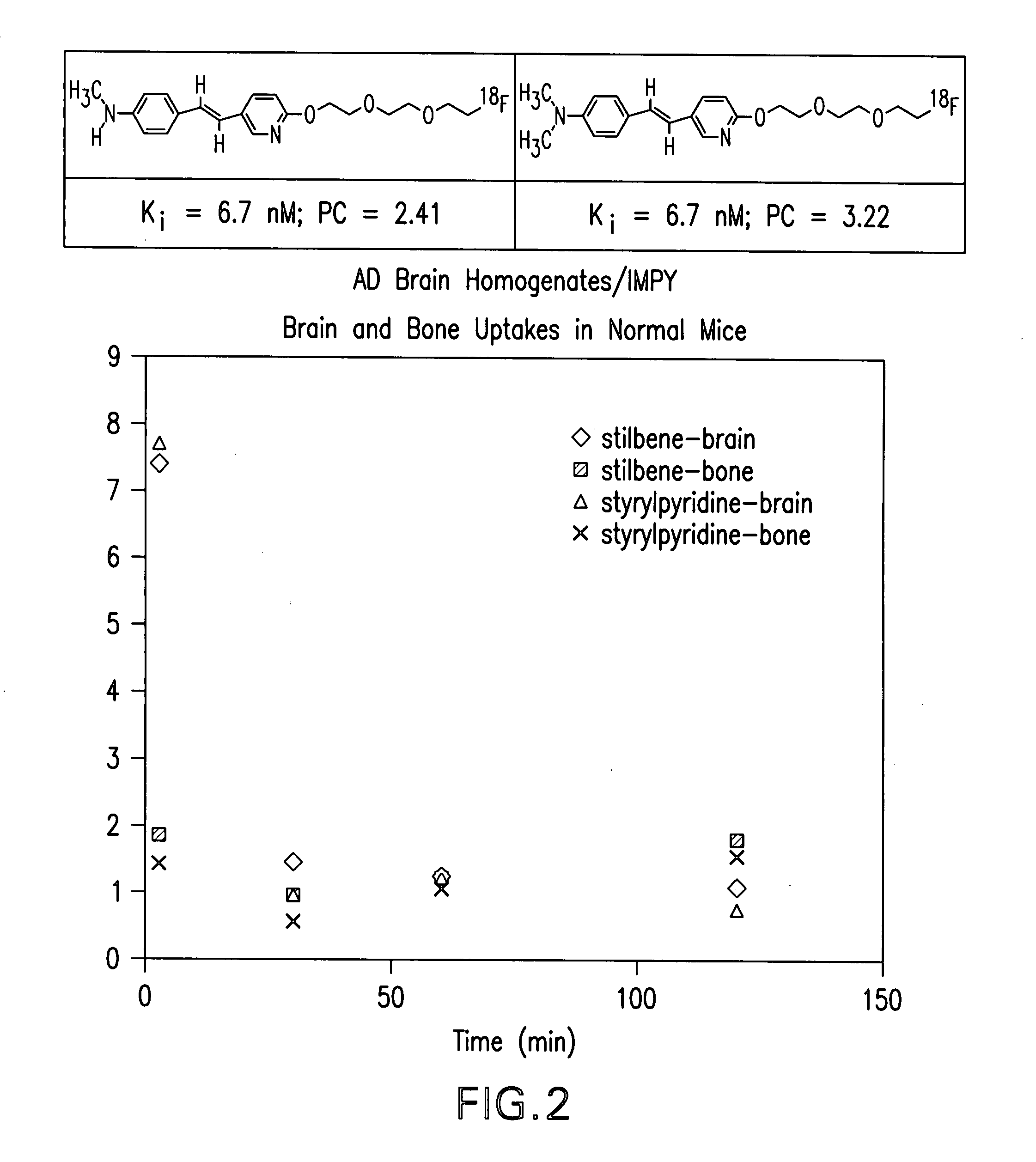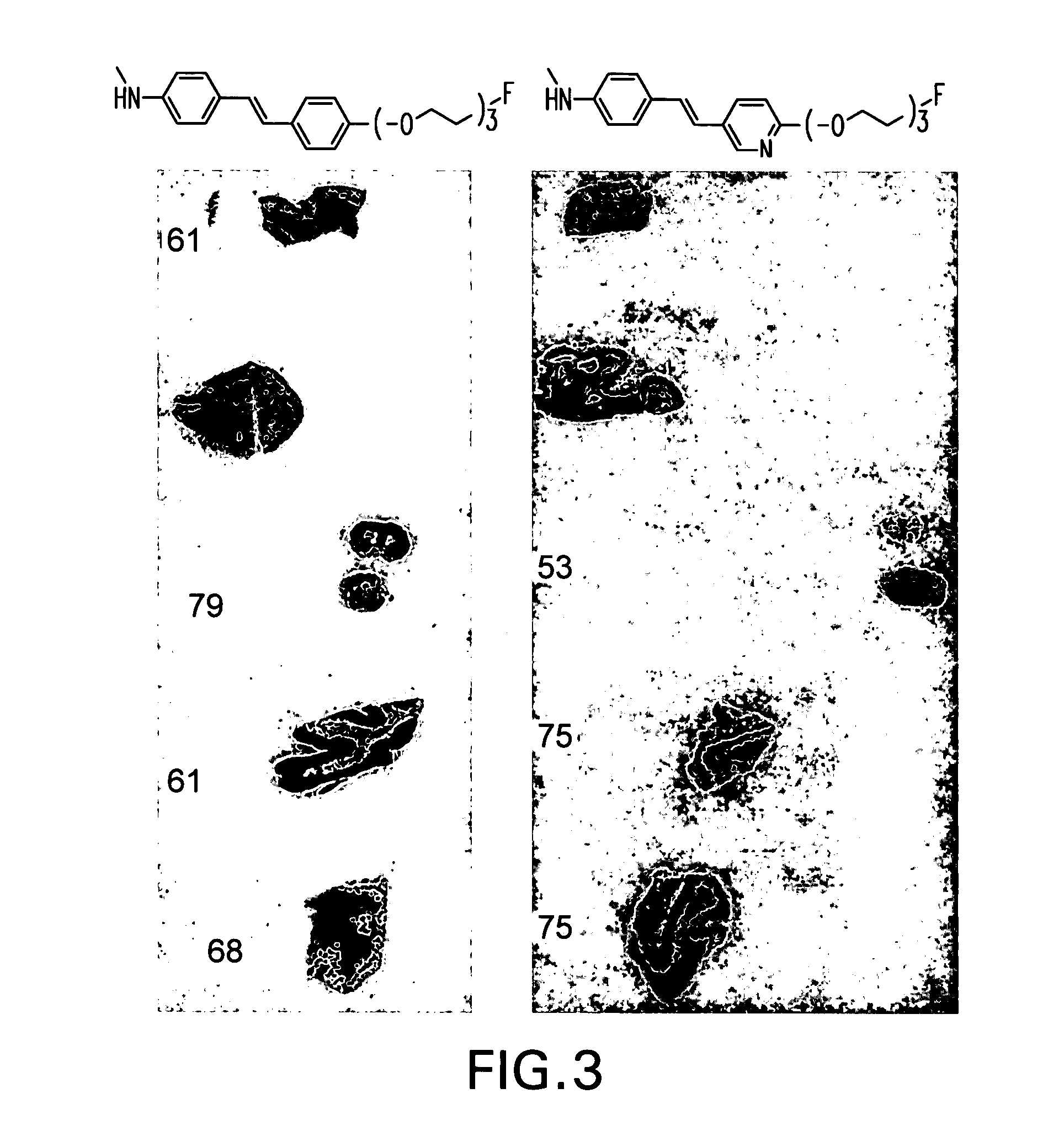Stryrylpyridine derivates and theur use for binding and imaging amylod plaques
a technology of stryrylpyridine and amylod plaques, which is applied in the field of styrylpyridine compounds, can solve the problems of amyloid deposits being difficult to direct imaging in vivo, and amyloid deposits being difficult to imag
- Summary
- Abstract
- Description
- Claims
- Application Information
AI Technical Summary
Benefits of technology
Problems solved by technology
Method used
Image
Examples
example 1
Synthesis of Compound 2
(E)-2-chloro-5-(4-dimethylaminostyryl)pyridine (1)
[0167] Potassium tert-butoxide (99 mg, 0.89 mmol) was added to a solution of diethyl-(4-dimethylamino-benzyl)-phosphonate (80 mg, 0.30 mmol) in anhydrous DMF (5.0 ml) at 0° C. 2-Chloro-5-pyridyl aldehyde (42 mg, 0.30 mmol) was then added. The reaction mixture was warmed to room temperature and stirred for 4 h. Water was added and mixture was extracted with MeOH / DCM (1:9, v / v). Organic layer was separated, washed with brine, dried over sodium sulfate and evaporated. The residue was purified by PTLC (20% Hexanes in DCM as developing solvent) to give product 1 (48 mg, Yield: 62%). 1H NMR (200 MHz, CDCl3): δ.8.42 (1H, d, J=2.2 Hz), 7.77 (1H, d, d, J=8.4 Hz, J2=2.4 Hz), 7.41 (2H, d, J=8.6 Hz), 7.27 (1H, d, J=8.2 Hz), 7.08 (1H, d, J=16.4 Hz), 6.77 (3H, m), HRMS (EI) m / z calcd. for [C13H9ClN2O2]+ 260.0353.
(E)-2-(2-(2-(2-fluoroethoxy)ethoxy)ethoxy)-5-(4-dimethylaminostyryl)pyridine (2)
example 2
Synthesis of Compound 6
(E)-2-chloro-5-(4-nitrostyryl)pyridine (3)
[0169] Sodium methoxide (1 M in methanol, 5.0 ml) was added slowly into a solution of diethyl-(4-nitro-benzyl)-phosphonate (546 mg, 2.0 mmol) and 2-chloro-5-pyridyl aldehyde (283 mg, 2.0 mmol) in methanol (5.0 ml). The reaction mixture was then refluxed for 1 h. After cooled down to 0° C., yellow precipitate was filtered and washed with cold methanol to obtain product 3 (458 mg, Yield: 88%), which was used directly for next step without further purification. 3: 1H NMR (200 MHz, CDCl3): δ.8.53 (1H, d, J=2.4 Hz), 8.25 (2H, d, J=8.8 Hz), 7.85 (1H, d, d, J=8.4 Hz, J2=2.4 Hz), 7.65 (2H, d, J=8.8 Hz), 7.36 (1H, d, J=8.4 Hz), 7.19 (2H, s), HRMS (EI) m / z calcd. for [C13H9ClN2O2]+ 260.0353.
(E)-2-(2-(2-(2-fluoroethoxy)ethoxy)ethoxy)-5-(4-nitrostyryl)pyridine (4)
[0170] Under the protection of nitrogen atmosphere, 2-(2-(2-fluoroethoxy)ethoxy)-ethanola (60 mg, 0.39 mmol) was added into a mixture of sodium hydride (26.4 mg, 60% ...
example 3
Synthesis of Compound 10
(E)-2-(2-(2-(2-hydroxyethoxy)ethoxy)ethoxy)-5-(4-nitrostyryl)pyridine (7)
[0173] The mixture of potassium carbonate (158.7 mg, 1.15 mmol), compound 3 (100 mg, 0.38 mmol) and triethylene glycol (576 mg, 3.8 mmol) in anhydrous DMF (5.0 ml) was sealed in a microwavable vial (from Biotage) and subjected to microwave irradiation (Biotage Initiator system) at 180° C. for 25 min. After cooling to room temperature, water was added and reaction mixture was extracted with ethyl acetate. Organic layer was separated, washed with brine, dried over anhydrous sodium sulfate and evaporated. The residue was purified with PTLC (4% MeOH in DCM as developing solvent) gave product 7 (110 mg, Yield: 77%): 1H NMR (200 MHz, CDCl3): δ.8.20 (3H, m), 7.83 (1H, d, d, J=8.6 Hz, J2=2.4 Hz), 7.61 (2H, d, J=8.8 Hz), 7.10 (2H, m) 6.84 (1H, d, J=8.6 Hz), 4.53 (2H, t, J=4.8 Hz), 3.88 (2H, t, J=4.8 Hz), 3.71 (6H, m), 3.61 (2H, m), 2.10 (1H, b), HRMS (EI) m / z calcd. for [C19H22N2O6]+ 374.1478. ...
PUM
| Property | Measurement | Unit |
|---|---|---|
| Electric charge | aaaaa | aaaaa |
| Capacitance | aaaaa | aaaaa |
| Composition | aaaaa | aaaaa |
Abstract
Description
Claims
Application Information
 Login to View More
Login to View More - R&D
- Intellectual Property
- Life Sciences
- Materials
- Tech Scout
- Unparalleled Data Quality
- Higher Quality Content
- 60% Fewer Hallucinations
Browse by: Latest US Patents, China's latest patents, Technical Efficacy Thesaurus, Application Domain, Technology Topic, Popular Technical Reports.
© 2025 PatSnap. All rights reserved.Legal|Privacy policy|Modern Slavery Act Transparency Statement|Sitemap|About US| Contact US: help@patsnap.com



